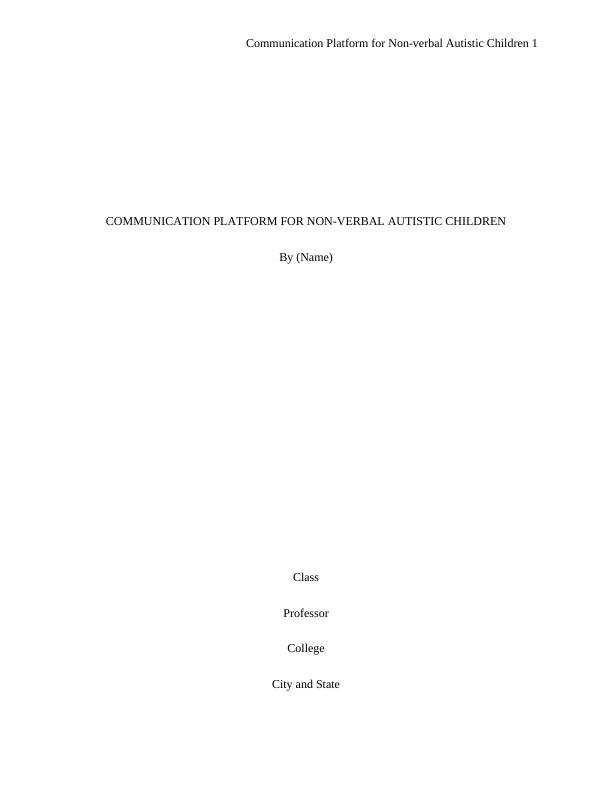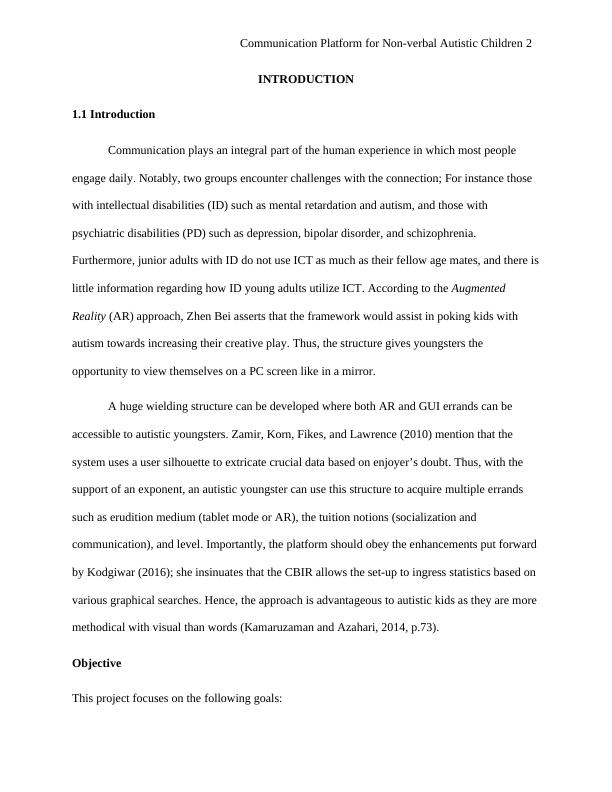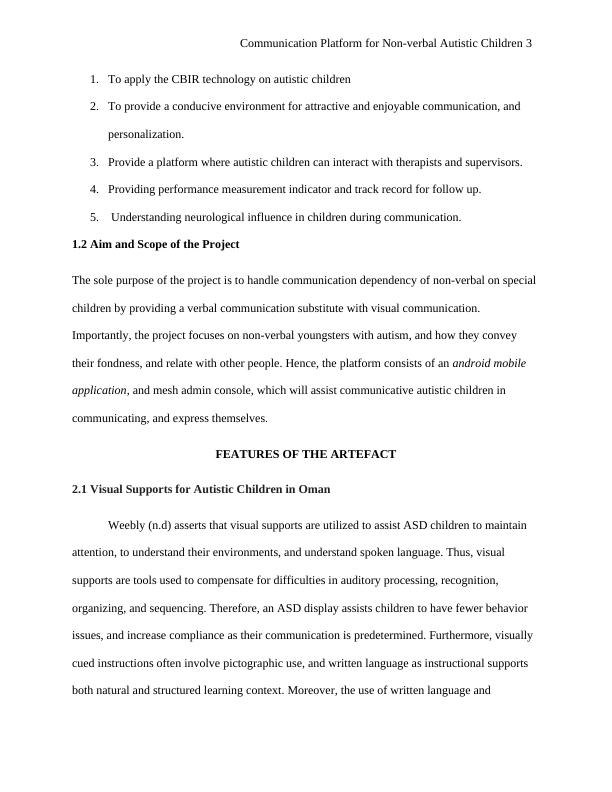Communication Platform for Non-verbal Autistic Children
Added on 2023-04-24
19 Pages5239 Words455 Views
Communication Platform for Non-verbal Autistic Children 1
COMMUNICATION PLATFORM FOR NON-VERBAL AUTISTIC CHILDREN
By (Name)
Class
Professor
College
City and State
COMMUNICATION PLATFORM FOR NON-VERBAL AUTISTIC CHILDREN
By (Name)
Class
Professor
College
City and State

Communication Platform for Non-verbal Autistic Children 2
INTRODUCTION
1.1 Introduction
Communication plays an integral part of the human experience in which most people
engage daily. Notably, two groups encounter challenges with the connection; For instance those
with intellectual disabilities (ID) such as mental retardation and autism, and those with
psychiatric disabilities (PD) such as depression, bipolar disorder, and schizophrenia.
Furthermore, junior adults with ID do not use ICT as much as their fellow age mates, and there is
little information regarding how ID young adults utilize ICT. According to the Augmented
Reality (AR) approach, Zhen Bei asserts that the framework would assist in poking kids with
autism towards increasing their creative play. Thus, the structure gives youngsters the
opportunity to view themselves on a PC screen like in a mirror.
A huge wielding structure can be developed where both AR and GUI errands can be
accessible to autistic youngsters. Zamir, Korn, Fikes, and Lawrence (2010) mention that the
system uses a user silhouette to extricate crucial data based on enjoyer’s doubt. Thus, with the
support of an exponent, an autistic youngster can use this structure to acquire multiple errands
such as erudition medium (tablet mode or AR), the tuition notions (socialization and
communication), and level. Importantly, the platform should obey the enhancements put forward
by Kodgiwar (2016); she insinuates that the CBIR allows the set-up to ingress statistics based on
various graphical searches. Hence, the approach is advantageous to autistic kids as they are more
methodical with visual than words (Kamaruzaman and Azahari, 2014, p.73).
Objective
This project focuses on the following goals:
INTRODUCTION
1.1 Introduction
Communication plays an integral part of the human experience in which most people
engage daily. Notably, two groups encounter challenges with the connection; For instance those
with intellectual disabilities (ID) such as mental retardation and autism, and those with
psychiatric disabilities (PD) such as depression, bipolar disorder, and schizophrenia.
Furthermore, junior adults with ID do not use ICT as much as their fellow age mates, and there is
little information regarding how ID young adults utilize ICT. According to the Augmented
Reality (AR) approach, Zhen Bei asserts that the framework would assist in poking kids with
autism towards increasing their creative play. Thus, the structure gives youngsters the
opportunity to view themselves on a PC screen like in a mirror.
A huge wielding structure can be developed where both AR and GUI errands can be
accessible to autistic youngsters. Zamir, Korn, Fikes, and Lawrence (2010) mention that the
system uses a user silhouette to extricate crucial data based on enjoyer’s doubt. Thus, with the
support of an exponent, an autistic youngster can use this structure to acquire multiple errands
such as erudition medium (tablet mode or AR), the tuition notions (socialization and
communication), and level. Importantly, the platform should obey the enhancements put forward
by Kodgiwar (2016); she insinuates that the CBIR allows the set-up to ingress statistics based on
various graphical searches. Hence, the approach is advantageous to autistic kids as they are more
methodical with visual than words (Kamaruzaman and Azahari, 2014, p.73).
Objective
This project focuses on the following goals:

Communication Platform for Non-verbal Autistic Children 3
1. To apply the CBIR technology on autistic children
2. To provide a conducive environment for attractive and enjoyable communication, and
personalization.
3. Provide a platform where autistic children can interact with therapists and supervisors.
4. Providing performance measurement indicator and track record for follow up.
5. Understanding neurological influence in children during communication.
1.2 Aim and Scope of the Project
The sole purpose of the project is to handle communication dependency of non-verbal on special
children by providing a verbal communication substitute with visual communication.
Importantly, the project focuses on non-verbal youngsters with autism, and how they convey
their fondness, and relate with other people. Hence, the platform consists of an android mobile
application, and mesh admin console, which will assist communicative autistic children in
communicating, and express themselves.
FEATURES OF THE ARTEFACT
2.1 Visual Supports for Autistic Children in Oman
Weebly (n.d) asserts that visual supports are utilized to assist ASD children to maintain
attention, to understand their environments, and understand spoken language. Thus, visual
supports are tools used to compensate for difficulties in auditory processing, recognition,
organizing, and sequencing. Therefore, an ASD display assists children to have fewer behavior
issues, and increase compliance as their communication is predetermined. Furthermore, visually
cued instructions often involve pictographic use, and written language as instructional supports
both natural and structured learning context. Moreover, the use of written language and
1. To apply the CBIR technology on autistic children
2. To provide a conducive environment for attractive and enjoyable communication, and
personalization.
3. Provide a platform where autistic children can interact with therapists and supervisors.
4. Providing performance measurement indicator and track record for follow up.
5. Understanding neurological influence in children during communication.
1.2 Aim and Scope of the Project
The sole purpose of the project is to handle communication dependency of non-verbal on special
children by providing a verbal communication substitute with visual communication.
Importantly, the project focuses on non-verbal youngsters with autism, and how they convey
their fondness, and relate with other people. Hence, the platform consists of an android mobile
application, and mesh admin console, which will assist communicative autistic children in
communicating, and express themselves.
FEATURES OF THE ARTEFACT
2.1 Visual Supports for Autistic Children in Oman
Weebly (n.d) asserts that visual supports are utilized to assist ASD children to maintain
attention, to understand their environments, and understand spoken language. Thus, visual
supports are tools used to compensate for difficulties in auditory processing, recognition,
organizing, and sequencing. Therefore, an ASD display assists children to have fewer behavior
issues, and increase compliance as their communication is predetermined. Furthermore, visually
cued instructions often involve pictographic use, and written language as instructional supports
both natural and structured learning context. Moreover, the use of written language and

Communication Platform for Non-verbal Autistic Children 4
pictographic enhance children’s organization skills, academic learning, general skill
development, socialization, and communication. These children usually suffer from recognition
problems, social impairments, repetitive behavior, and communication issues. The educative
game that is displayed in the computer assists in treating autistic kids, by improving their
recognition, and communication skills (Iyer, and Kalbande, 2014, p.414).
2.1.1 Autistic Profile
The ASD prevalence in Oman is unknown. Al-Farsi et al. (2011, p. 821) assert that a
study showed that ASD was more common in boys at a prevalence rate of 75 percent, and among
the low-income families. The ASD low prevalence in Oman is due to under-reporting, and
under-diagnosis.
Most of the symptoms of ASD manifest after three years, and a formal diagnosis is made
when the child is five-years-old. In the 1970s, Western nations experienced a rise in reports on
an increase in the rate of ASD cases. Contrary, in the Middle East there has been a relatively less
number of cases reported as ASD is not a normal research subject. The objective of the autistic
profile is to gauge the ubiquity of ASD among youngsters between 4 and 11 years in Oman,
which is an upper-middle income nation with approximately 3.5 million people. Notably, 42.7
percent of this population is below 15 years.
Occurrences were noted and surveilled from all the medical facilities, and social
institutes, which offer earmarked services to people living with ASD in Oman. It included one
tertiary medical facility with a child psychiatry unit, and eight communal centers for exceptional
needs youngsters. Conversely, clinical data regarding the exhibitions was obtained from the
health history at the tertiary facility, and its index was the solitary origin of information for
pictographic enhance children’s organization skills, academic learning, general skill
development, socialization, and communication. These children usually suffer from recognition
problems, social impairments, repetitive behavior, and communication issues. The educative
game that is displayed in the computer assists in treating autistic kids, by improving their
recognition, and communication skills (Iyer, and Kalbande, 2014, p.414).
2.1.1 Autistic Profile
The ASD prevalence in Oman is unknown. Al-Farsi et al. (2011, p. 821) assert that a
study showed that ASD was more common in boys at a prevalence rate of 75 percent, and among
the low-income families. The ASD low prevalence in Oman is due to under-reporting, and
under-diagnosis.
Most of the symptoms of ASD manifest after three years, and a formal diagnosis is made
when the child is five-years-old. In the 1970s, Western nations experienced a rise in reports on
an increase in the rate of ASD cases. Contrary, in the Middle East there has been a relatively less
number of cases reported as ASD is not a normal research subject. The objective of the autistic
profile is to gauge the ubiquity of ASD among youngsters between 4 and 11 years in Oman,
which is an upper-middle income nation with approximately 3.5 million people. Notably, 42.7
percent of this population is below 15 years.
Occurrences were noted and surveilled from all the medical facilities, and social
institutes, which offer earmarked services to people living with ASD in Oman. It included one
tertiary medical facility with a child psychiatry unit, and eight communal centers for exceptional
needs youngsters. Conversely, clinical data regarding the exhibitions was obtained from the
health history at the tertiary facility, and its index was the solitary origin of information for

End of preview
Want to access all the pages? Upload your documents or become a member.
